Abstract
1. We recorded the electrical activity of single afferent cardiac fibres isolated from the third and fourth left thoracic sympathetic rami communicantes of anaesthetized cats. Their conduction velocities ranged from 12 to 32 m/sec.
2. The endings of each fibre were localized to one cardiac chamber by mechanical probing of the opened heart performed at the end of the experiment.
3. The impulse activity was spontaneous and, in fibres with atrial or ventricular endings, it was in phase with a particular atrial or ventricular event.
4. This nervous activity increased during increases in pressure occurring in the chamber where the endings were located. Conversely, decreases in pressure were accompanied by decreased nervous discharge.
5. In some experiments the left coronary artery was perfused at different flows and pressures. Brief decreases or increases in coronary flow and pressure decreased or increased, respectively, the discharge of fibres with atrial or ventricular endings. Fibres were excited by intracoronary injections of veratridine.
6. Cessation of coronary pump flow increased the discharge of fibres with atrial or ventricular endings only when myocardial ischaemia was accompanied by signs of heart failure.
7. These afferent cardiac sympathetic fibres which provide the spinal cord with continuous specific information on cardiac events are likely to contribute to the neural control of circulation.
Full text
PDF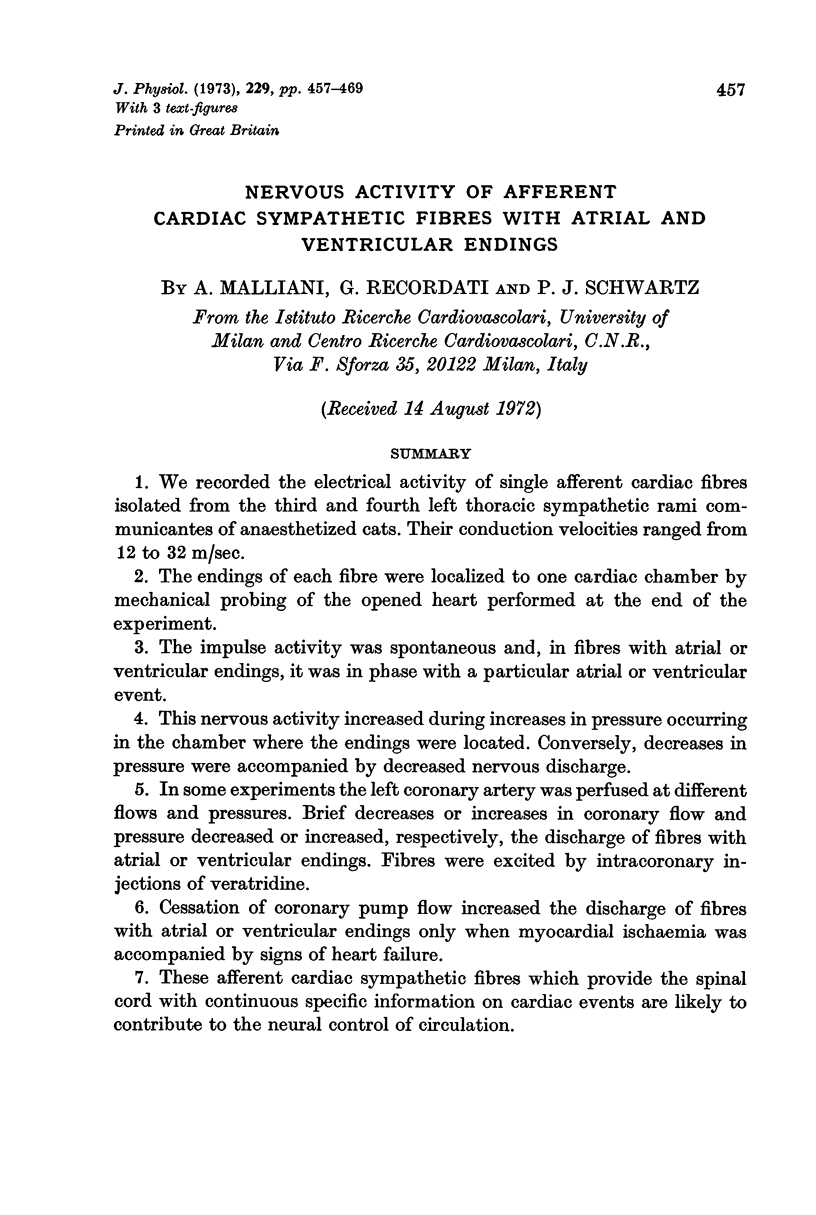
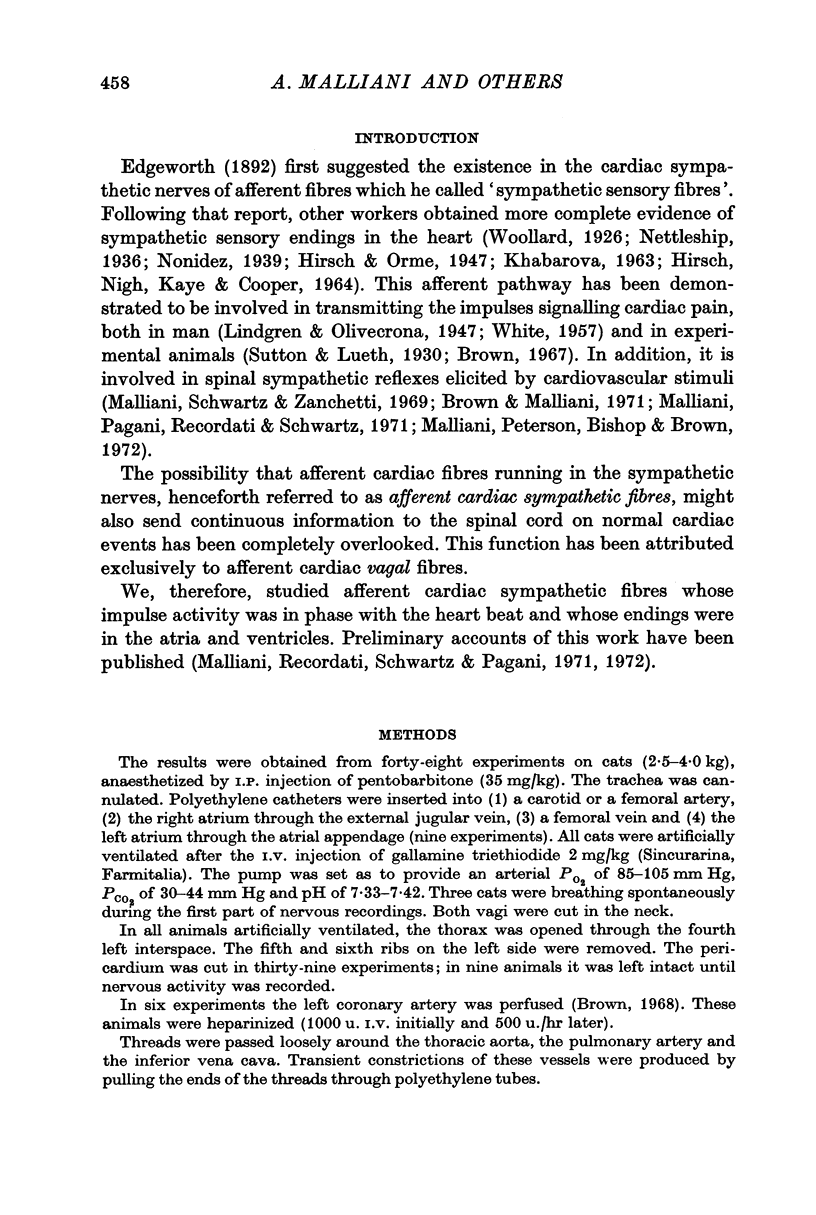
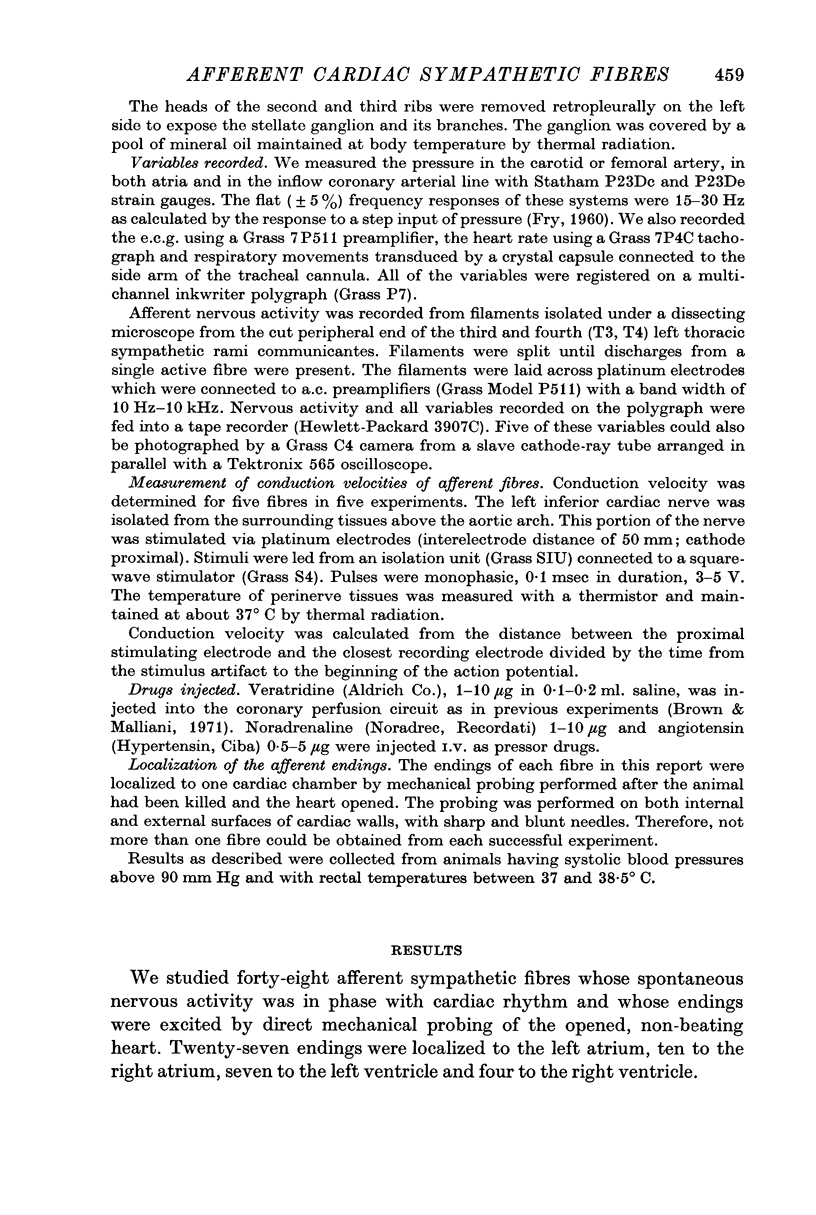
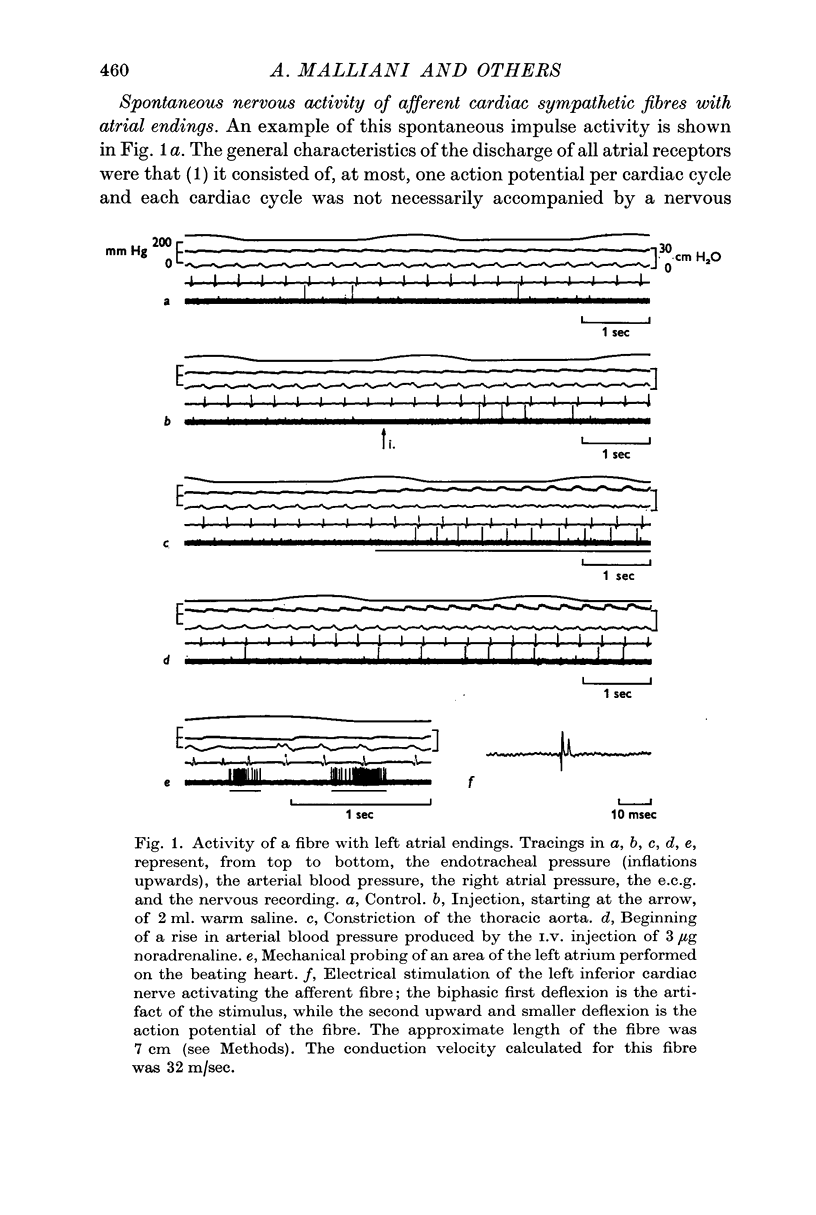
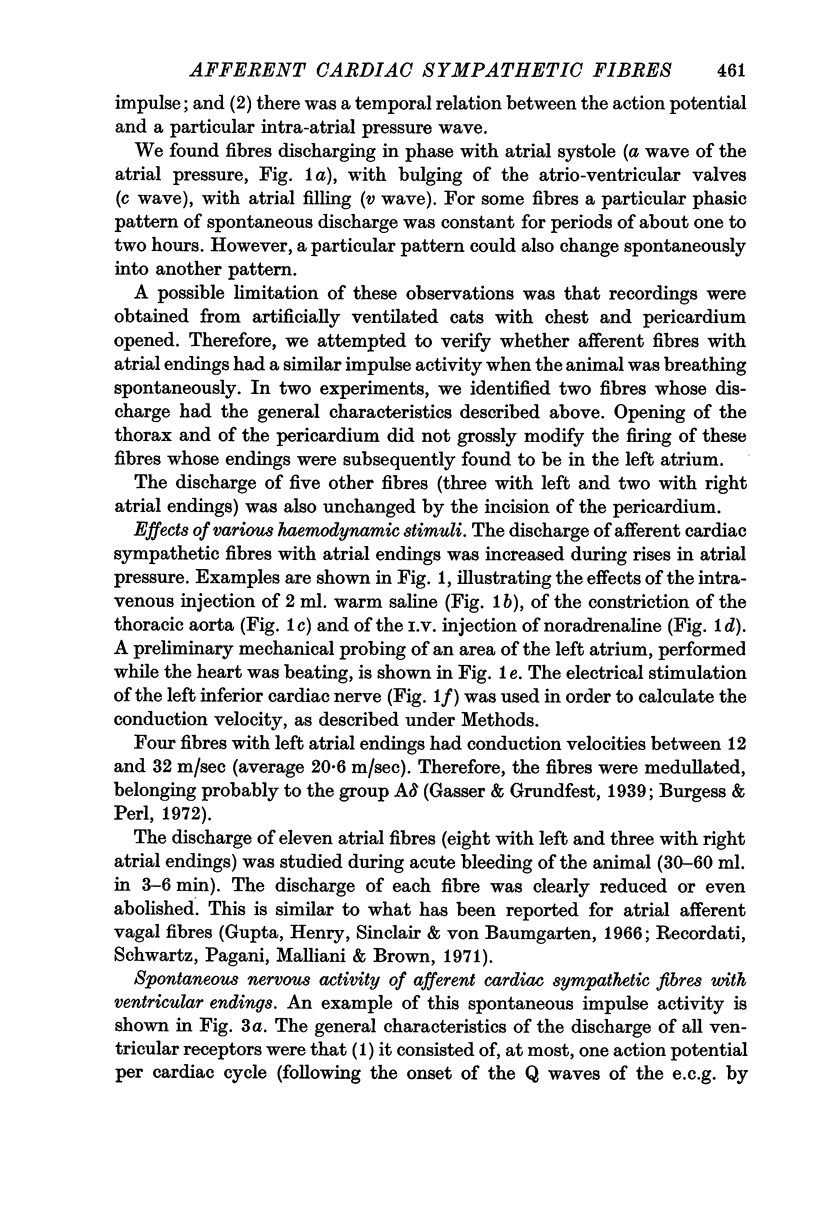
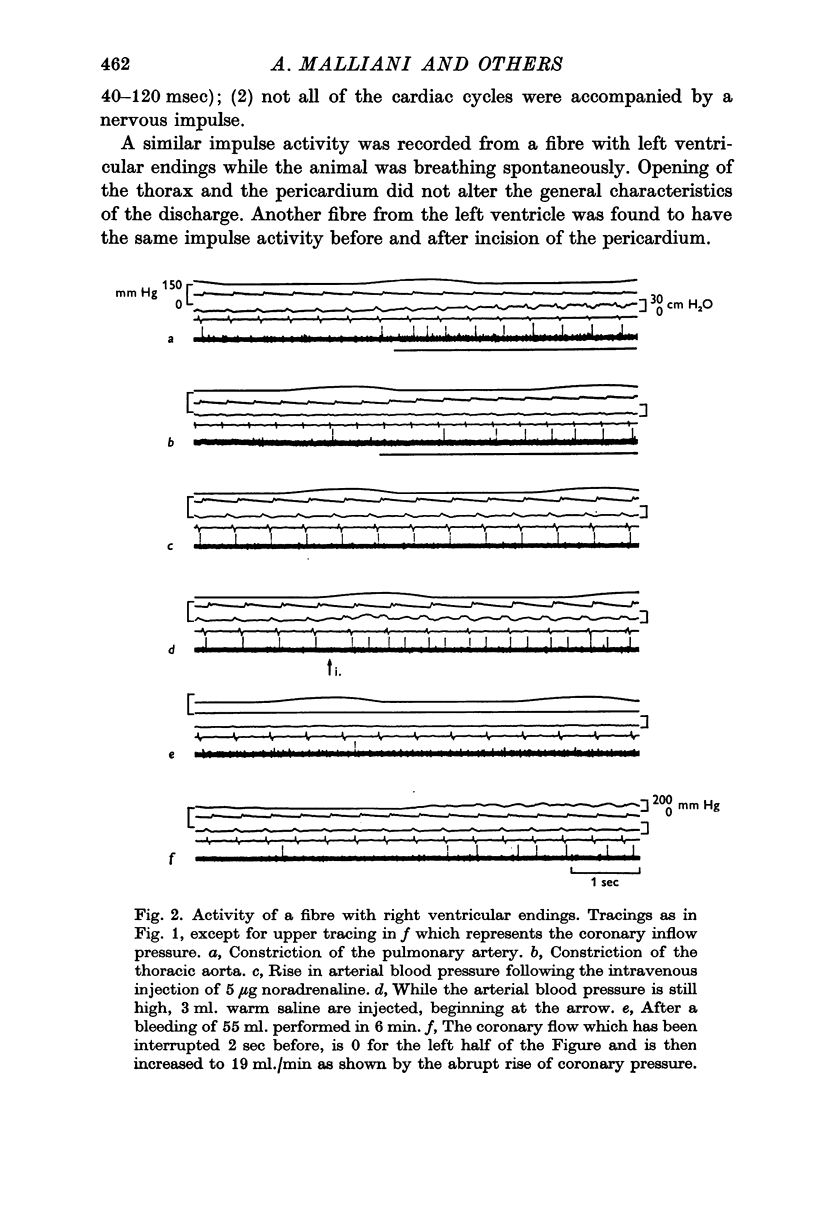
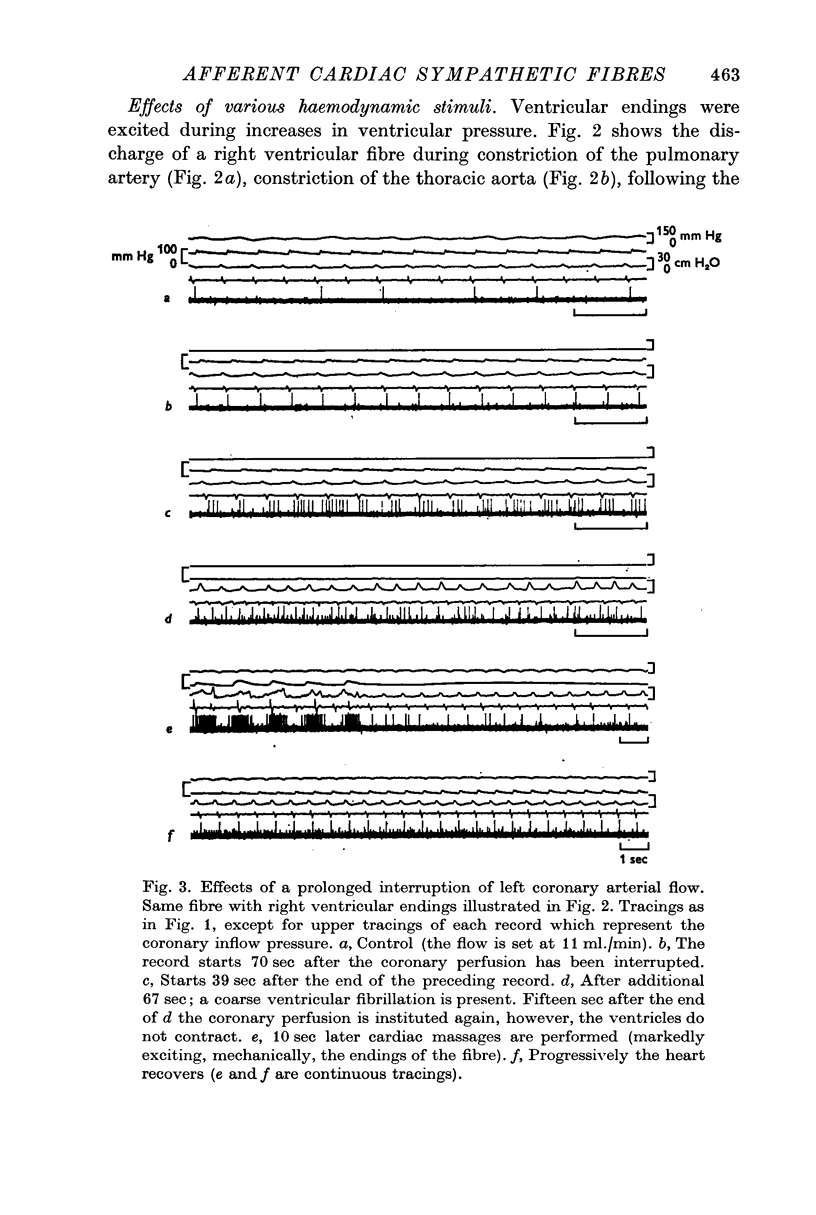
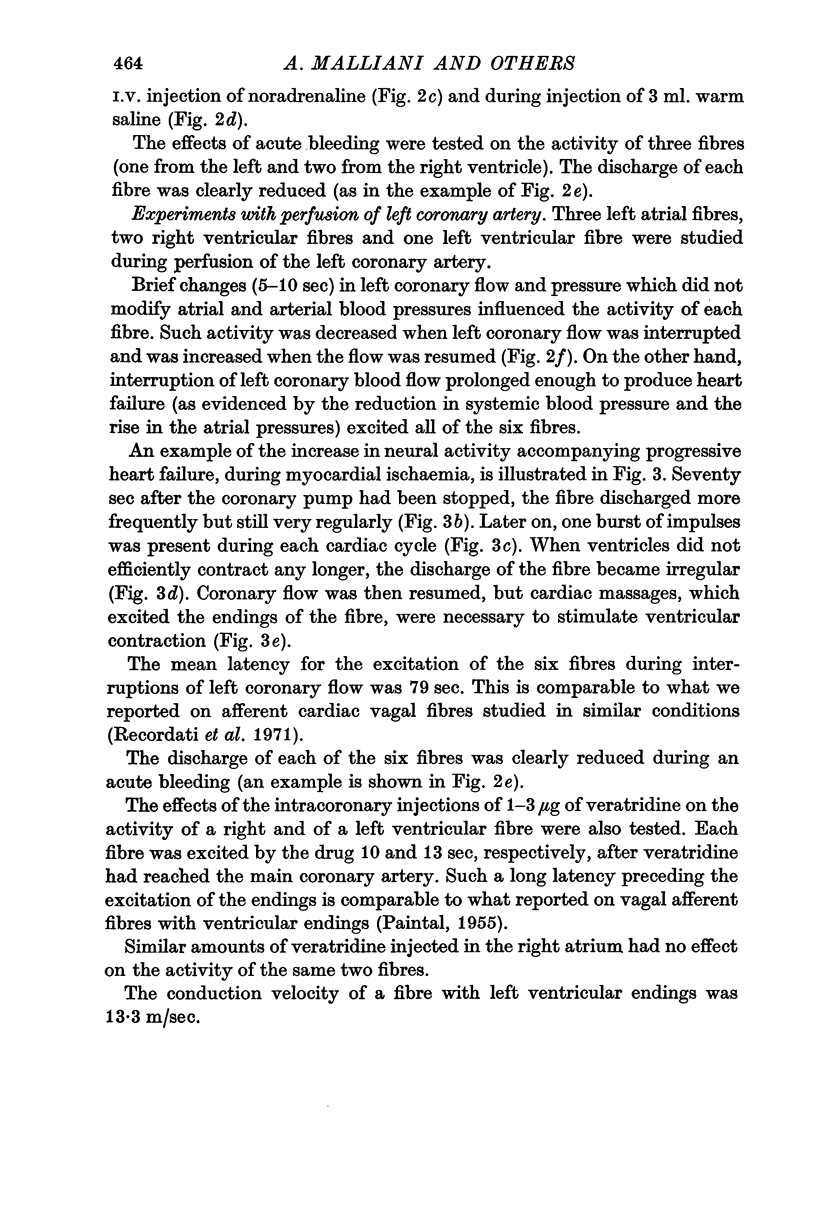
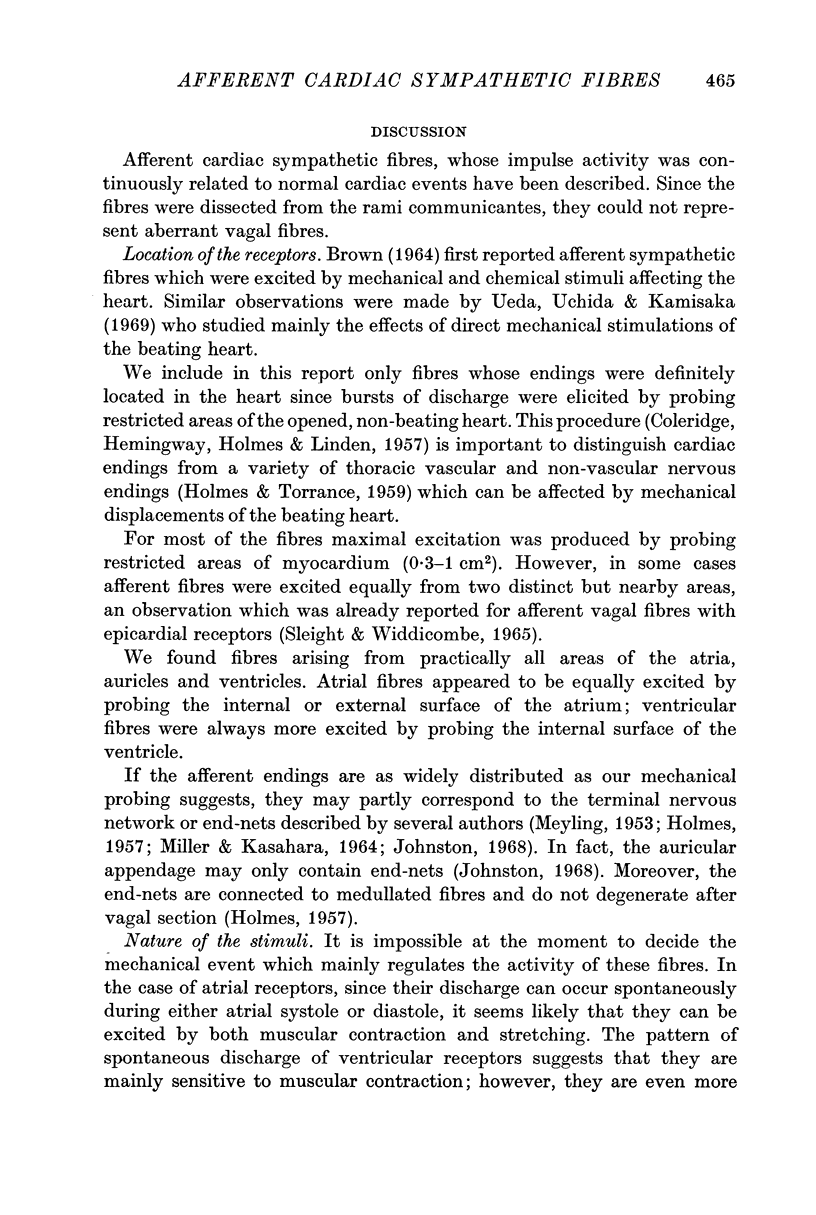
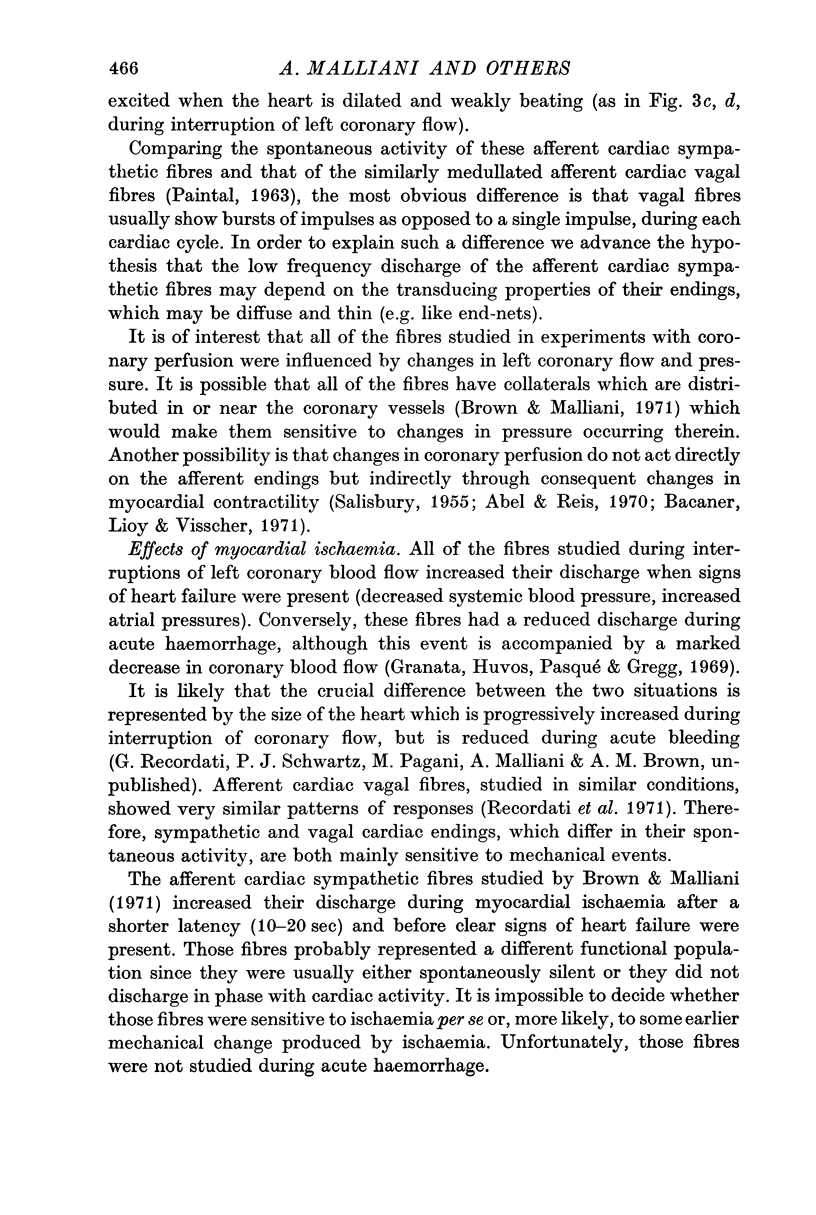
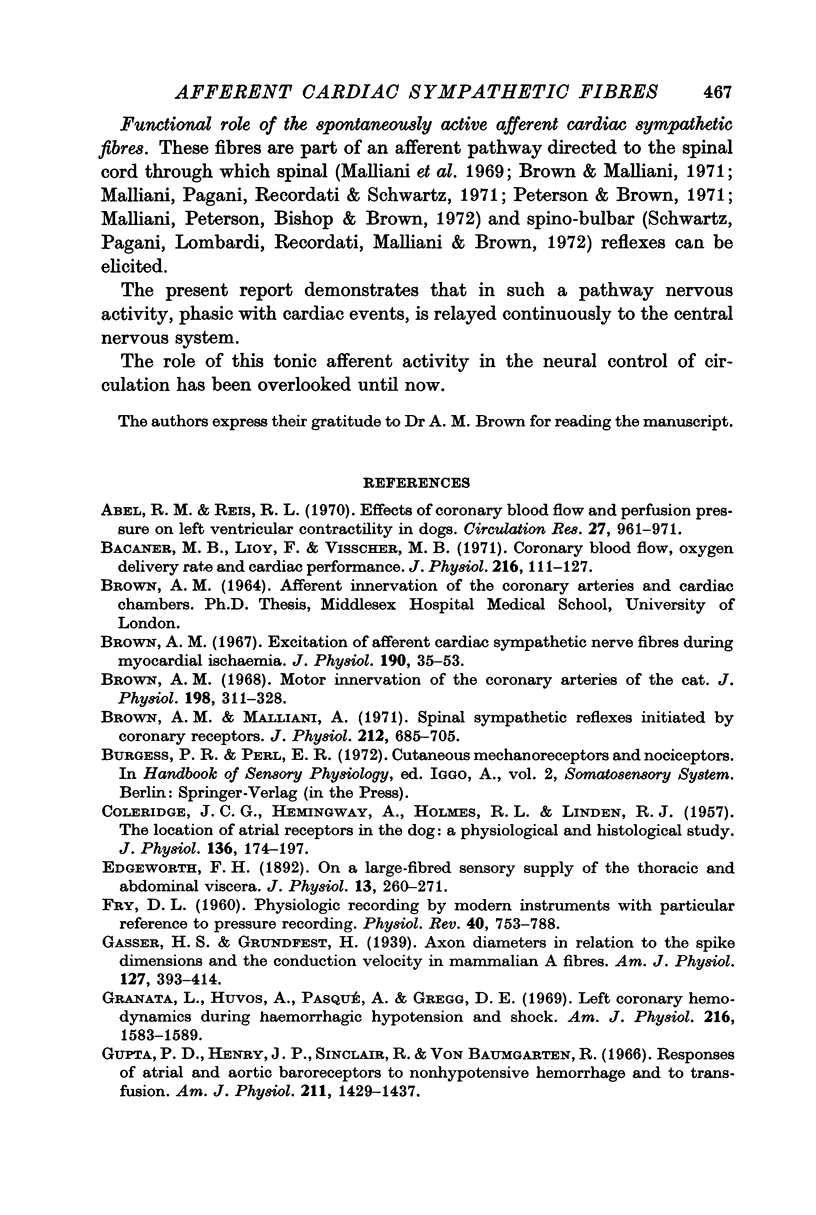
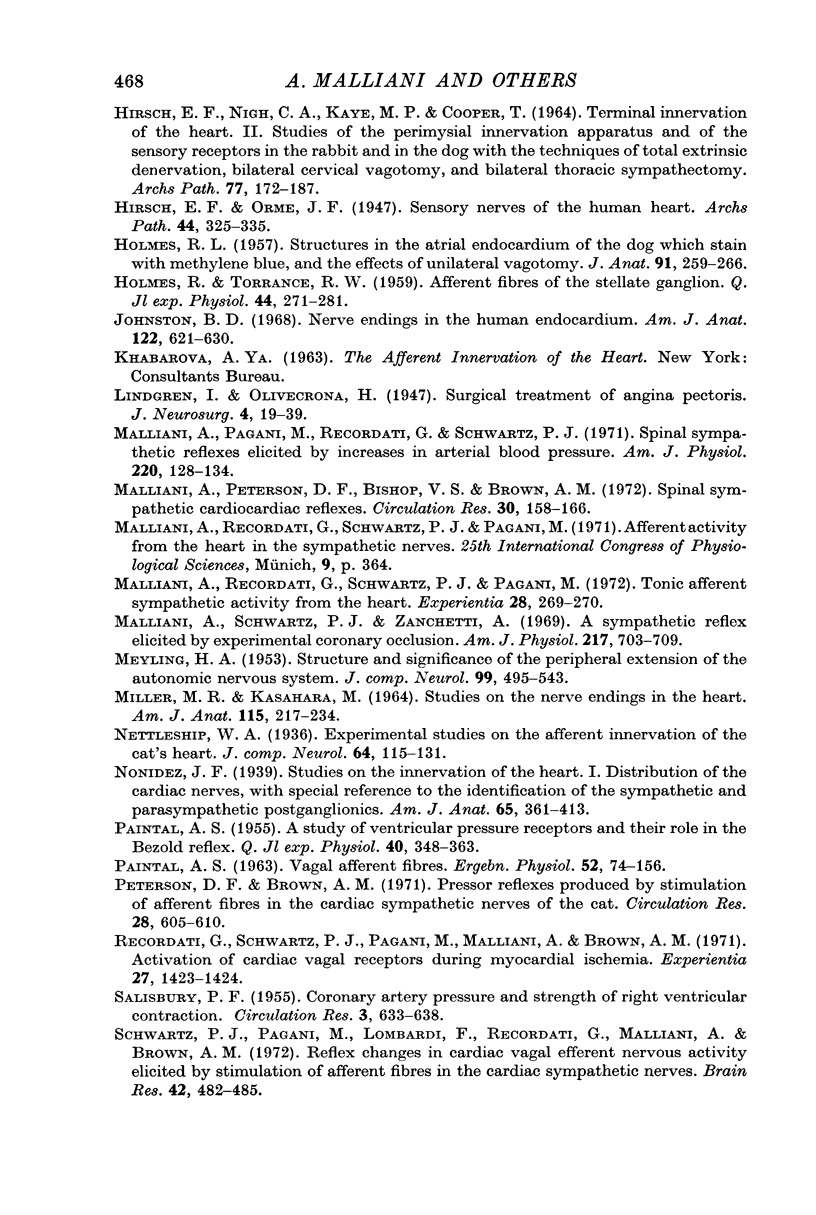
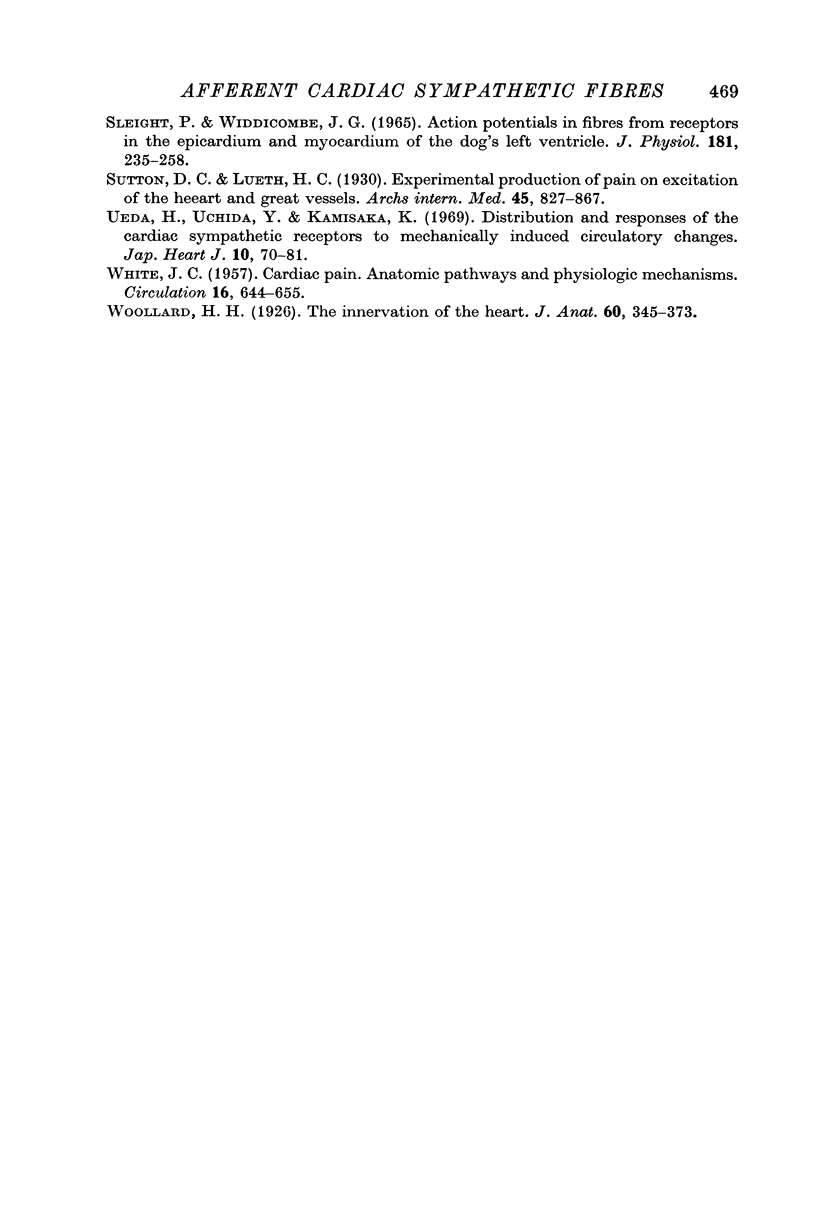
Selected References
These references are in PubMed. This may not be the complete list of references from this article.
- Abel R. M., Reis R. L. Effects of coronary blood flow and perfusion pressure on left ventricular contractility in dogs. Circ Res. 1970 Dec;27(6):961–971. doi: 10.1161/01.res.27.6.961. [DOI] [PubMed] [Google Scholar]
- Bacaner M. B., Lioy F., Visscher M. B. Coronary blood flow, oxygen delivery rate and cardiac performance. J Physiol. 1971 Jul;216(1):111–127. doi: 10.1113/jphysiol.1971.sp009512. [DOI] [PMC free article] [PubMed] [Google Scholar]
- Brown A. M. Excitation of afferent cardiac sympathetic nerve fibres during myocardial ischaemia. J Physiol. 1967 May;190(1):35–53. doi: 10.1113/jphysiol.1967.sp008191. [DOI] [PMC free article] [PubMed] [Google Scholar]
- Brown A. M., Malliani A. Spinal sympathetic reflexes initiated by coronary receptors. J Physiol. 1971 Feb;212(3):685–705. doi: 10.1113/jphysiol.1971.sp009350. [DOI] [PMC free article] [PubMed] [Google Scholar]
- Brown A. M. Motor innervation of the coronary arteries of the cat. J Physiol. 1968 Sep;198(2):311–328. doi: 10.1113/jphysiol.1968.sp008608. [DOI] [PMC free article] [PubMed] [Google Scholar]
- COLERIDGE J. C., HEMINGWAY A., HOLMES R. L., LINDEN R. J. The location of atrial receptors in the dog: a physiological and histological study. J Physiol. 1957 Apr 3;136(1):174–197. doi: 10.1113/jphysiol.1957.sp005750. [DOI] [PMC free article] [PubMed] [Google Scholar]
- Edgeworth F. H. On a Large-fibred Sensory Supply of the Thoracic and Abdominal Viscera. J Physiol. 1892 May;13(3-4):260–271. doi: 10.1113/jphysiol.1892.sp000407. [DOI] [PMC free article] [PubMed] [Google Scholar]
- FRY D. L. Physiologic recording by modern instruments with particular reference to pressure recording. Physiol Rev. 1960 Oct;40:753–788. doi: 10.1152/physrev.1960.40.4.753. [DOI] [PubMed] [Google Scholar]
- Granata L., Huvos A., Pasquè A., Gregg D. E. Left coronary hemodynamics during hemorrhagic hypotension and shock. Am J Physiol. 1969 Jun;216(6):1583–1589. doi: 10.1152/ajplegacy.1969.216.6.1583. [DOI] [PubMed] [Google Scholar]
- Gupta P. D., Henry J. P., Sinclair R., Von Baumgarten R. Responses of atrial and aortic baroreceptors to nonhypotensive hemorrhage and to tranfusion. Am J Physiol. 1966 Dec;211(6):1429–1437. doi: 10.1152/ajplegacy.1966.211.6.1429. [DOI] [PubMed] [Google Scholar]
- HOLMES R. L. Structures in the atrial endocardium of the dog which stain with methylene blue, and the effects of unilateral vagotomy. J Anat. 1957 Apr;91(2):259–266. [PMC free article] [PubMed] [Google Scholar]
- HOLMES R., TORRANCE R. W. Afferent fibres of the stellate ganglion. Q J Exp Physiol Cogn Med Sci. 1959 Jul;44:271–281. doi: 10.1113/expphysiol.1959.sp001400. [DOI] [PubMed] [Google Scholar]
- Johnston B. D. Nerve endings in the human endocardium. Am J Anat. 1968 May;122(3):621–629. doi: 10.1002/aja.1001220312. [DOI] [PubMed] [Google Scholar]
- MEYLING H. A. Structure and significance of the peripheral extension of the autonomic nervous system. J Comp Neurol. 1953 Dec;99(3):495–543. doi: 10.1002/cne.900990304. [DOI] [PubMed] [Google Scholar]
- MILLER M. R., KASAHARA M. STUDIES ON THE NERVE ENDINGS IN THE HEART. Am J Anat. 1964 Sep;115:217–233. doi: 10.1002/aja.1001150203. [DOI] [PubMed] [Google Scholar]
- Malliani A., Pagani M., Recordati G., Schwartz P. J. Spinal sympathetic reflexes elicited by increases in arterial blood pressure. Am J Physiol. 1971 Jan;220(1):128–134. doi: 10.1152/ajplegacy.1971.220.1.128. [DOI] [PubMed] [Google Scholar]
- Malliani A., Peterson D. F., Bishop V. S., Brown A. M. Spinal sympathetic cardiocardiac reflexes. Circ Res. 1972 Feb;30(2):158–166. doi: 10.1161/01.res.30.2.158. [DOI] [PubMed] [Google Scholar]
- Malliani A., Recordati G., Schwartz P. J., Pagaui M. Tonic afferent sympathetic activity from the heart. Experientia. 1972 Mar 15;28(3):269–270. doi: 10.1007/BF01928681. [DOI] [PubMed] [Google Scholar]
- Malliani A., Schwartz P. J., Zanchetti A. A sympathetic reflex elicited by experimental coronary occlusion. Am J Physiol. 1969 Sep;217(3):703–709. doi: 10.1152/ajplegacy.1969.217.3.703. [DOI] [PubMed] [Google Scholar]
- PAINTAL A. S. A study of ventricular pressure receptors and their role in the Bezold reflex. Q J Exp Physiol Cogn Med Sci. 1955 Oct;40(4):348–363. doi: 10.1113/expphysiol.1955.sp001135. [DOI] [PubMed] [Google Scholar]
- PAINTAL A. S. VAGAL AFFERENT FIBRES. Ergeb Physiol. 1963;52:74–156. [PubMed] [Google Scholar]
- Peterson D. F., Brown A. M. Pressor reflexes produced by stimulation of afferent fibers in the cardiac sympathetic nerves of the cat. Circ Res. 1971 Jun;28(6):605–610. doi: 10.1161/01.res.28.6.605. [DOI] [PubMed] [Google Scholar]
- Recordati G., Schwartz P. J., Pagani M., Malliani A., Brown A. M. Activation of cardiac vagal receptors during myocardial ischemia. Experientia. 1971 Dec 15;27(12):1423–1424. doi: 10.1007/BF02154267. [DOI] [PubMed] [Google Scholar]
- SALISBURY P. F. Coronary artery pressure and strength of right ventricular contraction. Circ Res. 1955 Nov;3(6):633–638. doi: 10.1161/01.res.3.6.633. [DOI] [PubMed] [Google Scholar]
- Schwartz P. J., Pagani M., Lombardi F., Recordati G., Malliani A., Brown A. M. Reflex changes in cardiac vagal efferent nervous acitivty elicited by stimulation of afferent fibres in the cardiac sympathetic nerves. Brain Res. 1972 Jul 20;42(2):482–485. doi: 10.1016/0006-8993(72)90546-x. [DOI] [PubMed] [Google Scholar]
- Sleight P., Widdicombe J. G. Action potentials in fibres from receptors in the epicardium and myocardium of the dog's left ventricle. J Physiol. 1965 Nov;181(2):235–258. doi: 10.1113/jphysiol.1965.sp007758. [DOI] [PMC free article] [PubMed] [Google Scholar]
- Ueda H., Uchida Y., Kamisaka K. Distribution and responses of the cardiac sympathetic receptors to mechanically induced circulatory changes. Jpn Heart J. 1969 Jan;10(1):70–81. doi: 10.1536/ihj.10.70. [DOI] [PubMed] [Google Scholar]
- WHITE J. C. Cardiac pain: anatomic pathways and physiologic mechanisms. Circulation. 1957 Oct;16(4):644–655. doi: 10.1161/01.cir.16.4.644. [DOI] [PubMed] [Google Scholar]
- Woollard H. H. The Innervation of the Heart. J Anat. 1926 Jul;60(Pt 4):345–373. [PMC free article] [PubMed] [Google Scholar]


